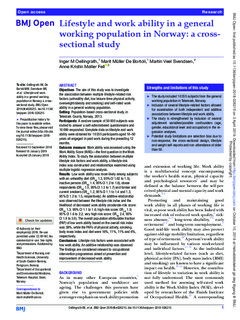| dc.contributor.author | Oellingrath, Inger Margaret | |
| dc.contributor.author | Müller De Bortoli, Marit | |
| dc.contributor.author | Svendsen, Martin Veel | |
| dc.contributor.author | Fell, Anne Kristin Møller | |
| dc.date.accessioned | 2019-10-21T12:53:19Z | |
| dc.date.available | 2019-10-21T12:53:19Z | |
| dc.date.created | 2019-04-09T09:54:04Z | |
| dc.date.issued | 2019 | |
| dc.identifier.citation | BMJ Open. 2019, 9 (4) . | nb_NO |
| dc.identifier.issn | 2044-6055 | |
| dc.identifier.uri | http://hdl.handle.net/11250/2623562 | |
| dc.description | Re-use permitted under CC BY-NC. Nocommercial re-use. See rights and permissions. | nb_NO |
| dc.description.abstract | Objectives The aim of this study was to investigate the association between multiple lifestyle-related risk factors (unhealthy diet, low leisure-time physical activity, overweight/obesity and smoking) and self-rated work ability in a general working population. Setting Population-based cross-sectional study, in Telemark County, Norway, 2013. Participants A random sample of 50 000 subjects was invited to answer a self-administered questionnaire and 16 099 responded. Complete data on lifestyle and work ability were obtained for 10 355 participants aged 18–50 years all engaged in paid work during the preceding 12 months. Outcome measure Work ability was assessed using the Work Ability Score (WAS)—the first question in the Work Ability Index. To study the association between multiple lifestyle risk factors and work ability, a lifestyle risk index was constructed and relationships examined using multiple logistic regression analysis. Results Low work ability was more likely among subjects with an unhealthy diet (ORadj 1.3, 95% CI 1.02 to 1.5), inactive persons (ORadj 1.4, 95% CI 1.2 to 1.6), obese respondents (ORadj 1.5, 95% CI 1.3 to 1.7) and former and current smokers (ORadj 1.2, 95% CI 1.1 to 1.4 and 1.3, 95% CI 1.2 to 1.5, respectively). An additive relationship was observed between the lifestyle risk index and the likelihood of decreased work ability (moderate-risk score: ORadj 1.3; 95% CI 1.1 to 1.6; high-risk score: ORadj 1.9; 95% CI 1.6 to 2.2; very high risk score: ORadj 2.4; 95% CI 1.9 to 3.0). The overall population attributable fraction (PAF) of low work ability based on the overall risk index was 38%, while the PAFs of physical activity, smoking, body mass index and diet were 16%, 11%, 11% and 6%, respectively. Conclusions Lifestyle risk factors were associated with low work ability. An additive relationship was observed. The findings are considered relevant to occupational intervention programmes aimed at prevention and improvement of decreased work ability. | nb_NO |
| dc.description.abstract | Lifestyle and work ability in a general working population in Norway: a cross-sectional study | nb_NO |
| dc.language.iso | eng | nb_NO |
| dc.rights | Navngivelse 4.0 Internasjonal | * |
| dc.rights.uri | http://creativecommons.org/licenses/by/4.0/deed.no | * |
| dc.title | Lifestyle and work ability in a general working population in Norway: a cross-sectional study | nb_NO |
| dc.type | Journal article | nb_NO |
| dc.type | Peer reviewed | nb_NO |
| dc.description.version | publishedVersion | nb_NO |
| dc.rights.holder | © Author(s) (or their employer(s)) 2019. | nb_NO |
| dc.source.pagenumber | 9 | nb_NO |
| dc.source.volume | 9 | nb_NO |
| dc.source.journal | BMJ Open | nb_NO |
| dc.source.issue | 4 | nb_NO |
| dc.identifier.doi | 10.1136/bmjopen-2018-026215 | |
| dc.identifier.cristin | 1691014 | |
| cristin.unitcode | 222,56,1,0 | |
| cristin.unitname | Institutt for sykepleie- og helsevitenskap | |
| cristin.ispublished | true | |
| cristin.fulltext | original | |
| cristin.qualitycode | 1 | |

